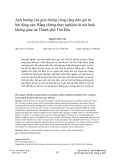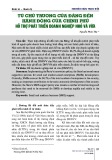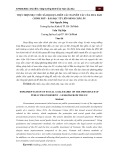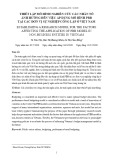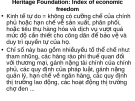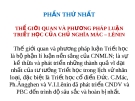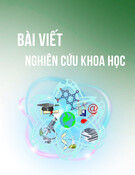
Chapter 11
Public Goods and Common Resources
TRUE/FALSE
1. When goods are available free of charge, the market forces that normally allocate resources in our economy
are absent.
ANS: T DIF: 2 REF: 11-0
NAT: Analytic LOC: Markets, market failure, and externalities
TOP: Market failure MSC: Interpretive
2. Free goods are usually efficiently allocated without government intervention.
ANS: F DIF: 2 REF: 11-0
NAT: Analytic LOC: Markets, market failure, and externalities
TOP: Market failure MSC: Interpretive
3. Most goods in our economy are allocated in markets, where buyers pay for what they receive and sellers are
paid for what they provide.
ANS: T DIF: 1 REF: 11-0
NAT: Analytic LOC: The Study of economics, and definitions in economics
TOP: Private goods MSC: Applicative
4. Government intervention cannot improve the allocation of resources for goods that do not have prices attached
to them.
ANS: F DIF: 2 REF: 11-0
NAT: Analytic LOC: The role of government TOP: Public goods
MSC: Interpretive
5. A good that is excludable but not rival is known as a natural monopoly.
ANS: T DIF: 1 REF: 11-1
NAT: Analytic LOC: The Study of economics, and definitions in economics
TOP: Natural monopolies MSC: Definitional
6. National Public Radio would be considered a natural monopoly.
ANS: F DIF: 2 REF: 11-1
NAT: Analytic LOC: The Study of economics, and definitions in economics
TOP: Natural monopolies MSC: Interpretive
7. Concerts in arenas are not excludable because it is virtually impossible to prevent someone from seeing the
show.
ANS: F DIF: 1 REF: 11-1
NAT: Analytic LOC: The Study of economics, and definitions in economics
TOP: Excludability MSC: Applicative
8. A pair of jeans is rival but non-excludable.
ANS: F DIF: 1 REF: 11-1
NAT: Analytic LOC: The Study of economics, and definitions in economics
TOP: Excludability | Rivalry in consumption MSC: Applicative
9. A good that is rival in consumption is one that someone can be prevented from using if she did not pay for it.
ANS: F DIF: 1 REF: 11-1
NAT: Analytic LOC: The Study of economics, and definitions in economics
TOP: Excludability | Rivalry in consumption MSC: Definitional
220

221 Chapter 11/Public Goods and Common Resources
10. Some goods can be classified as either public goods or private goods depending on the circumstances.
ANS: T DIF: 2 REF: 11-1
NAT: Analytic LOC: The Study of economics, and definitions in economics
TOP: Public goods | Private goods MSC: Interpretive
11. Roads can be considered either public goods or common resources, depending on how congested they are.
ANS: T DIF: 1 REF: 11-1
NAT: Analytic LOC: The Study of economics, and definitions in economics
TOP: Public goods | Common resources MSC: Applicative
12. When one person enjoys the benefit of a tornado siren, she reduces the benefit to others.
ANS: F DIF: 1 REF: 11-1
NAT: Analytic LOC: The Study of economics, and definitions in economics
TOP: Rivalry in consumption MSC: Applicative
13. Some goods, such as lighthouses, can switch between being public goods and being private goods depending
on the circumstances.
ANS: T DIF: 2 REF: 11-2
NAT: Analytic LOC: Understanding and applying economic models
TOP: Public goods | private goods MSC: Interpretive
14. A free-rider is someone who receives the benefit of a good but avoids paying for it.
ANS: T DIF: 1 REF: 11-2
NAT: Analytic LOC: The Study of economics, and definitions in economics
TOP: Free riders MSC: Definitional
15. A free rider is a person who pays for a good but does not receive the benefit of it.
ANS: F DIF: 1 REF: 11-2
NAT: Analytic LOC: The Study of economics, and definitions in economics
TOP: Free riders MSC: Definitional
16. One benefit to the patent system is that it encourages the production of technical knowledge.
ANS: T DIF: 1 REF: 11-2
NAT: Analytic LOC: Markets, market failure, and externalities
TOP: Excludability MSC: Applicative
17. Government agencies, such as the National Science Foundation, subsidize basic research because in the
absence of a subsidy too little research would be conducted.
ANS: T DIF: 1 REF: 11-2
NAT: Analytic LOC: Markets, market failure, and externalities
TOP: Public goods MSC: Applicative
18. Although national defense is currently a public good, economists who advocate small government generally
agree that the U.S. should privatize national defense to increase the efficiency of the good.
ANS: F DIF: 2 REF: 11-2
NAT: Analytic LOC: The Study of economics, and definitions in economics
TOP: Public goods MSC: Interpretive
19. In some cases the government can make everyone better off by raising taxes to pay for certain goods that the
market fails to provide.
ANS: T DIF: 2 REF: 11-2
NAT: Analytic LOC: The role of government TOP: Public goods
MSC: Interpretive
20. Even economists who advocate small government agree that national defense is a good that the government
should provide.
ANS: T DIF: 1 REF: 11-2
NAT: Analytic LOC: The role of government TOP: Public goods
MSC: Applicative

Chapter 11/Public Goods and Common Resources 222
21. Advocates of antipoverty programs claim that fighting poverty is a public good.
ANS: T DIF: 1 REF: 11-2
NAT: Analytic LOC: Understanding and applying economic models
TOP: Public goods MSC: Applicative
22. Private markets usually provide lighthouses because ship captains have the incentive to navigate using the
lighthouse and therefore will pay for the service.
ANS: F DIF: 2 REF: 11-2
NAT: Analytic LOC: Markets, market failure, and externalities
TOP: Public goods MSC: Interpretive
23. The free-rider problem arises when the number of beneficiaries is large and exclusion of any of them is
impossible.
ANS: T DIF: 1 REF: 11-2
NAT: Analytic LOC: The Study of economics, and definitions in economics
TOP: Free riders MSC: Applicative
24. A study that compares the costs and benefits to society of providing a public good is called externality
analysis.
ANS: F DIF: 1 REF: 11-2
NAT: Analytic LOC: The Study of economics, and definitions in economics
TOP: Cost-benefit analysis MSC: Definitional
25. Economists argue that we can calculate the value of a human life by observing voluntary risks that people take
every day.
ANS: T DIF: 2 REF: 11-2
NAT: Analytic LOC: The Study of economics, and definitions in economics
TOP: Cost-benefit analysis MSC: Applicative
26. If we can conclude that human life has a finite value, cost-benefit analysis can lead to solutions in which
human life is worth less than the cost of a potential project.
ANS: T DIF: 2 REF: 11-2
NAT: Analytic LOC: The Study of economics, and definitions in economics
TOP: Cost-benefit analysis MSC: Interpretive
27. Aristotle writes, “What is common to many is taken least care of, for all men have greater regard for what is
their own than for what they possess in common with others.” In this statement, Aristotle is referring to the
free-rider problem that occurs when a person receives the benefit of a good without paying for it.
ANS: F DIF: 2 REF: 11-3
NAT: Analytic LOC: The Study of economics, and definitions in economics
TOP: Tragedy of the Commons MSC: Interpretive
28. One solution to the “Tragedy of the Commons” is to turn the common resource into a private good.
ANS: T DIF: 1 REF: 11-3
NAT: Analytic LOC: The Study of economics, and definitions in economics
TOP: Tragedy of the Commons MSC: Interpretive
29. An example of the “Tragedy of the Commons” is litter in the picnic area of a local park.
ANS: T DIF: 2 REF: 11-3
NAT: Analytic LOC: The Study of economics, and definitions in economics
TOP: Tragedy of the Commons MSC: Applicative
30. London charges drivers driving in “congestion zones” a tax in order to reduce traffic congestion.
ANS: T DIF: 1 REF: 11-3
NAT: Analytic LOC: Markets, market failure, and externalities
TOP: Common resources MSC: Applicative

223 Chapter 11/Public Goods and Common Resources
31. Governments that chose to make endangered elephants private goods have met with more success protecting
elephants than governments that chose to make killing elephants illegal.
ANS: T DIF: 2 REF: 11-3
NAT: Analytic LOC: Markets, market failure, and externalities
TOP: Common resources MSC: Interpretive
32. One person's use of common resources does not reduce the enjoyment other people receive from the resource.
ANS: F DIF: 2 REF: 11-3
NAT: Analytic LOC: The Study of economics, and definitions in economics
TOP: Common resources MSC: Applicative
33. If Toby and Pete are the only two fishermen in town and neither is bothered by the other's fishing, the lake
they fish in is not a common resource.
ANS: T DIF: 2 REF: 11-3
NAT: Analytic LOC: Understanding and applying economic models
TOP: Common resources MSC: Interpretive
34. One possible solution to the problem of protecting a common resource is to convert that resource to a private
good.
ANS: T DIF: 2 REF: 11-3
NAT: Analytic LOC: The Study of economics, and definitions in economics
TOP: Common resources MSC: Interpretive
35. Tolls are not effective in altering people's incentives to drive during rush hour.
ANS: F DIF: 2 REF: 11-3
NAT: Analytic LOC: The Study of economics, and definitions in economics
TOP: Common resources MSC: Applicative
36. The profit motive that stems from private ownership means that elephant populations are best protected as
common resources.
ANS: F DIF: 2 REF: 11-3
NAT: Analytic LOC: The Study of economics, and definitions in economics
TOP: Common resources MSC: Interpretive
37. In the Tragedy of the Commons, joint action among the individual citizens would be necessary to solve their
common resource problem unless the government intervenes.
ANS: T DIF: 2 REF: 11-3
NAT: Analytic LOC: The Study of economics, and definitions in economics
TOP: Tragedy of the Commons MSC: Applicative
38. Depending on congestion, national parks can be either a common resource or a public good.
ANS: T DIF: 2 REF: 11-3
NAT: Analytic LOC: The Study of economics, and definitions in economics
TOP: Common resources | Public goods MSC: Interpretive
39. Markets may fail to allocate resources efficiently when property rights are not well established.
ANS: T DIF: 1 REF: 11-4
TOP: Property rights MSC: Interpretive

Chapter 11/Public Goods and Common Resources 224
SHORT ANSWER
1. Place each of the following in the correct location in the table.
Rival?
Yes No
Excludable? Yes Private Goods Natural Monopolies
No Common Resources Public Goods
a. Congested toll roads
b. Knowledge
c. Fish in the ocean
d. National defense
e. Congested nontoll roads
f. Cable TV
g. The environment
h. Fire protection
i. Ice-cream cones
j. Uncongested toll roads
k. Clothing
l. Uncongested nontoll roads
ANS:
Rival?
Yes No
Excludable?
Yes
Private Goods
Ice-cream cones
Clothing
Congested toll roads
Natural Monopolies
Fire protection
Cable TV
Uncongested toll roads
No
Common Resources
Fish in the ocean
The environment
Congested nontoll roads
Public Goods
National defense
Knowledge
Uncongested nontoll roads
DIF: 1 REF: 11-1 NAT: Analytic
LOC: The Study of economics, and definitions in economics
TOP: Excludability | Rivalry in consumption MSC: Applicative
2. The creation of knowledge is a public good. Because knowledge is a public good, profit-seeking firms tend to
free-ride on the knowledge created by others and, as a result, devote too few resources to the creation of
knowledge. How does the U.S. government correct for this apparent market failure?
ANS:
The government assigns and protects the property rights of the producers of specific, technological knowledge
through patents. The inventor will obtain much of the benefit of his invention. The U.S. government also subsidizes
basic research in many different fields.
DIF: 1 REF: 11-2 NAT: Analytic
LOC: The role of government TOP: Public goods
MSC: Applicative



